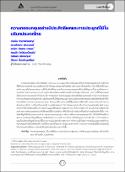บทคัดย่อ
ความครอบคลุมอย่างมีประสิทธิผล (effective coverage) เป็นการต่อยอดการวัดความครอบคลุมของบริการสุขภาพที่ใช้กันอย่างแพร่หลายมาแต่เดิมโดยคำนึงถึงคุณภาพและประโยชน์ของบริการเหล่านั้นร่วมด้วย ในช่วงยี่สิบปีที่ผ่านมา องค์การอนามัยโลกและหน่วยงานที่เกี่ยวข้องได้พยายามนำความครอบคลุมอย่างมีประสิทธิผลมาเป็นส่วนหนึ่งของการประเมินความสามารถของระบบบริการสุขภาพและติดตามผลลัพธ์ของหลักประกันสุขภาพถ้วนหน้า บทความนี้มีวัตถุประสงค์เพื่อทบทวนวรรณกรรมเกี่ยวกับนิยาม วิธีการประเมินความครอบคลุมอย่างมีประสิทธิผล และประสบการณ์การประเมินของต่างประเทศและของประเทศไทย และสังเคราะห์เป็นข้อเสนอแนะการประเมินความครอบคลุมอย่างมีประสิทธิผลสำหรับประเทศไทย การทบทวนวรรณกรรม พบว่า นิยามและวิธีการประเมินที่ใช้ในแต่ละการศึกษามีความหลากหลาย สร้างความสับสนในการสื่อสาร เปรียบเทียบและตีความ ผู้นิพนธ์เสนอว่านิยามที่เหมาะสมสำหรับบริบทประเทศไทยคือ สัดส่วนของประชากรที่จำเป็นต้องได้รับบริการสุขภาพและได้รับผลดีทางสุขภาพจากการใช้บริการสุขภาพ นิยามนี้ สามารถสื่อสารได้ตรงตามความหมายและลดความซับซ้อนของวิธีการประเมิน การคัดเลือกบริการสุขภาพที่จะนำมาประเมินควรคำนึงถึง ภาระโรคสำคัญลำดับต้นๆ ของประเทศ ความสามารถของระบบสุขภาพในการเพิ่มความครอบคลุมของบริการที่ก่อให้เกิดผลดีทางสุขภาพ และมีแหล่งข้อมูลที่มีคุณภาพเพียงพอในการประเมิน ความท้าทายที่สำคัญของการประเมิน คือ การกำหนดนิยามและเงื่อนไขของข้อมูลที่จะนำมาใช้ในการประเมินแต่ละบริการสุขภาพ การทำความเข้าใจผลการประเมิน และสาเหตุที่ความครอบคลุมอย่างมีประสิทธิผลต่ำ รวมทั้งความเท่าเทียมระหว่างกลุ่มประชากรต่างๆ กระบวนการประเมินที่มีส่วนร่วมของผู้เกี่ยวข้องจะช่วยให้ผลการประเมินมีประโยชน์ต่อนโยบายมากยิ่งขึ้น
บทคัดย่อ
Effective coverage is a concept of measuring health gain which incorporates health needs, utilization of health services, and the benefits to patients from using them into a single metric. In the past two decades, the World Health Organization and other agencies advocated the use of effective coverage as a way to assess health systems performance and track outcomes of universal health coverage. Two main objectives of this paper were to review literature relevant to definition, methodologies, and international and domestic experience; and to synthesize the recommendations for effective coverage assessment in the Thai context. The literature review found discrepancies of definition and measurement across various studies which caused confusions in communication, comparison and interpretation of the results. The authors proposed that Thailand should apply the definition of ‘the proportion of a population in need of a service that had a positive health outcome from using the service’. This definition communicated clearer meaning and reduced methodological complexities. Selection of proxy interventions should be guided by national health priorities, the possibility of making a positive change in the coverage and health gain, and reliable data sources. Key challenges of measuring effective coverage include defining operational criteria, understanding data requirement and results of low coverage as well as inequity dimensions across sub-population groups. Stakeholder participatory process of effective coverage monitoring should improve policy usefulness.


